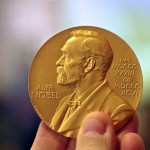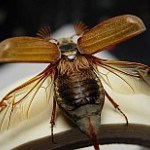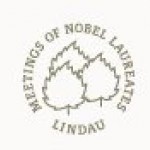Nobel prize
On Pharyngula, PZ Myers examines the work of Yoshinori Ohsumi, who was awarded the prize in Physiology for his studies of autophagy in yeast. Autophagy, or self-consumption, is a strategy used by all cells to recycle malfunctioning bits of themselves, or to survive during times of starvation. But autophagy is also involved in cancer metastasis and may play a role in other diseases such as Parkinson's. Meanwhile, the Nobel prize in Physics did not go to LIGO and the observation of gravitational waves as widely expected. Instead it was divided between three individuals for "theoretical…
Our researchers often appear in the pages of Nature, Science, etc, but here is one we think is worth mentioning: Christoph A. Thaiss, a PhD student in the immunology group of Dr. Eran Elinav, recently appeared in Nature – as an interviewer of Bruce Beutler, who shared one half of the 2011 Nobel Prize in Physiology or Medicine with Jules Hoffmann for their work on the activation of innate immunity. Thaiss and Beutler were at the Lindau meetings, where young researchers get to rub shoulders with Nobel laureates. Beutler, whose work has been called the second revolution in immunology says…
Earlier this week, the Nobel Prize in Physiology or Medicine was awarded to Youyou Tu for her discovery of the anti-malaria compound Artemisinin, as well as to William C. Campbell and Satoshi Ōmura for their discovery of a novel therapy for roundworm. Artemisinin, as some of you might know, is a compound derived from traditional Chinese medicine, which is why, to my irritation, it didn't take long for headlines like How traditional Chinese medicine finally won its Nobel Prize, What the 2015 Nobel Prizes mean for traditional Chinese medicine, and A Medical Breakthrough Made Possible By Ancient…
Not everyone gets their research written about by this week’s Nobel Prize winners:
All mammals face the challenge of navigating in complex, three-dimensional (3D) environments, whether they are swinging from branch-to-branch in forests or burrowing underground tunnels. How does the brain maintain a sense of place and direction in 3D? In a beautiful study published on Nature's website today, Finkelstein et al. report that bats have an internal neural compass that tracks direction in 3D during both surface locomotion and flight.
That’s from Prof. May-Britt Moser in Nature’s “News and Views.”…
Gerty Theresa Cori -- Biochemist
Often considered one of the greatest women scientists of the 20th century. The first American woman to win the Nobel Prize in Physiology and Medicine; known for her discovery (with husband Carl Cori and physiologist Bernardo Houssay) of how the body metabolizes glucose
Born Gerty Theresa Radnitz in 1896 in Prague (then in the Austro-Hungarian Empire, now the Czech Republic), Gerty grew up at a time when women were marginalized in science and allowed few educational opportunities. However, at age sixteen and influenced by her uncle, (who was a professor of…
C.V. Raman – Physicist
First Indian scientist to win the Nobel Prize in Physics. Known for his pioneering work in the scattering of light, now commonly called the "Raman Effect"
In 1930, at a time of limited opportunities for Indian scientists, his groundbreaking work in optics and the scattering of light led him to become one of the most renowned scientists that India has ever produced!
C.V. Raman (born Chandrasekhara Venkata Raman in 1888 in Tiruchinapalli, Tamil Nadu, India) was raised in studious home environment. His father was a lecturer in mathematics and physics. C.V. would go on to…
Image from Reuters and The NY Times
Congratulations to Drs. Randy W. Schekman, Thomas C. Südhof and James E. Rothman (above left to right) for earning the 2013 Nobel Prize in Physiology or Medicine for their research in "discoveries of machinery regulating vesicle traffic, a major transport system in our cells."
Cells often make products like hormones and neurotransmitters that need to exit the cell in order to simulate or inhibit other cells. The reason these three scientists were selected for the award is that their research discovered how cells regulate the export of vesicles…
Here is a photo of one of the Golem computers on which Arieh Warshel and Michael Levitt -- this year's Nobel Prize in Chemistry winners, along with Martin Karplus -- did much of their original work.
Golem computer
My dad was a computer programmer at that time, so I have some idea of what their work must have entailed. To this science writer, that makes their feat nothing short of amazing.
The Golem, by the way, which is preserved in the basement of the Weizmann Institute's mathematics building, was not the first computer at the Institute. The WEIZAC (below) was built at the…
Last week in Stockholm (and Oslo), the 2009 Nobel Prize winners were gloriously hosted while giving their lectures and receiving their medals and diplomas. In Chemistry this year, the Nobel was shared by Venkatraman Ramakrishnan, Thomas A Steitz, and Ada E Yonath for their studies on the structure and function of the ribosome, a remarkable nucleoprotein complex that catalyzes the rapid, coordinated formation of peptide bonds as instructed by messenger RNA. My post on the day of the announcement in October was designed to counter the inevitable (and now realized) criticisms that the prize was…
Sorry, I generally like the guy, and I can't quite yet let go of all my hopes, audacious or not, but Barak Obama has not done anything to deserve that yet.
The winners of this year's Nobel Prize in Chemistry have been announced, and the prize will be shared equally between Venkatraman Ramakrishnan, Thomas Steitz, and Ada Yonath "for studies of the structure and function of the ribosome." The information encoded in DNA is decoded to produce functional proteins in two stages: transcription (DNA --> RNA) and translation (RNA --> protein). This prize was awarded for the work that described this second stage in atomic detail, and you can read more about it in the scientific background document released with the prize announcement. This prize…
Welcome visitors coming from a recommendation by Dr Carmen Drahl at C&ENtral Science, the blog of the American Chemical Society's Chemical & Engineering News (C&EN):
Terra Sig has a fantastic post about the chemistry prize. The money quote: "If I see electrons being pushed around, it's chemistry."
Thank you for the kind words, Dr Drahl. New readers, feel free to weigh in down in the comments as to your take on this year's Chemistry prize.
The 2009 Nobel Prize in Chemistry has been awarded to three amazing scientists who elucidated the chemical bond-by-chemical bond action of the…
Today, the Nobel Committee announced the winners of the 2009 Nobel Prize in Physiology or Medicine, equally shared between Elizabeth Blackburn of UCSF, Carol Greider of Johns Hopkins, and Jack Szostak of Harvard Medical School--all three American. This year's prize was awarded for the discovery of telomeres, the repeated sequences of DNA at the ends of chromosomes that protect the integrity of the chromosomal DNA, and for the discovery of telomerase, the enzyme that builds the telomeres.
This prize recognizes seminal work in molecular genetics and biology that unlocked some of the basic…
The tweet came just about an hour ago announcing the well-deserved and much-predicted award of the 2009 Nobel Prize in Physiology or Medicine to Elizabeth Blackburn, Carol Greider, and Jack Szostak for their work on "how chromosomes are protected by telomeres and the enzyme telomerase."
I wrote about this team and their accomplishments three years ago when the won the Albert Lasker Award for Basic Medical Research, considered the "American Nobel."
I said then:
Most cancer researchers, biochemists, and cell biologists know all three of these outstanding researchers. While I can't claim being…
The what???
Well, you see, one of the traditional events at the Lindau Nobel Laureates Meeting is the annual cockchafer speech. Let me explain that.
The first conference in 1951 ended with a gathering of all attending Nobel laureates and their host, Count Lennart Bernadotte, to take a group photograph. Unfortunately it turned out that the laureates felt quite uncomfortable in front of the camera - and a group photograph of annoyed men would not have given the right impression of the successful first meeting.
So, when Count Bernadotte saw a cockchafer lying on the ground, he picked it up and…
When the chemist Wilhelm Ostwald received the Nobel prize for his research on catalysis in 1909 he probably didn't expect that his field of work would still be one of the most important topics in modern chemistry one hundred years later. Nevertheless all three Nobel Prizes in chemistry in the last years were given to scientists that worked in catalysis research.
One of them, Gerhard Ertl will be giving a talk on the catalysis happening when solids are coated with gossamer surfaces. The scientist got the Nobel prize in 2007 and named his speech "From atoms to complexity - reactions on surfaces…
Annually focusing on a different discipline, the Nobel Laureates meet in Lindau (Southern Germany). This year's meeting is going to be about chemistry and we, the editors of ScienceBlogs.de will be covering all events along with seven blogging scientists.
Although there will of course be lots of articles in German, we also launched an English section of the blog in which the most interesting articles will be translated - may the readers of this site forgive occasional bumpiness in our language skills.
As mentioned earlier here, PZ Myers will also attend the conference. The main topic of this…
Earlier today, the Nobel committee announced that the 2008 Nobel Prize in Chemistry has been awarded to Osamu Shimomura, Martin Chalfie, and Roger Y. Tsien "for the discovery and development of the green fluorescent protein, GFP." There's much to be said for how useful a tool GFP has been in cellular biology, but Alex Palazzo has already covered it at The Daily Transcript, so go check out his post for more.
The winners of the 2008 Nobel Prize in Physiology or Medicine have been announced, and the prize has been awarded for early discoveries that have subsequently led to vaccines or treatments of two widespread virus-caused diseases. Half of the prize was awarded to Harald zur Hausen "for his discovery of human papilloma viruses causing cervical cancer" and one-fourth each was awarded to Francoise Barre-Sinoussi and Luc Montagnier "for their discovery of human immunodeficiency virus." For more, check out the official press release or the more detailed description of the prize-winning…
tags: Gerty Cori, 1947 Nobel Prize in Physiology or Medicine, glycogen metabolism, USPS commemorative stamps
A stamp featuring Biochemist Gerty Cori, who together with her husband won a Nobel Prize in 1947 for discovering how the body processes glycogen. Chemists found a small flaw in the drawing of the "cori ester" molecule, a derivative of glycogen discovered by Gerty, but the US Postal Service will issue the stamp anyway, in March.
Image: United States Postal Service [post box sized view].









